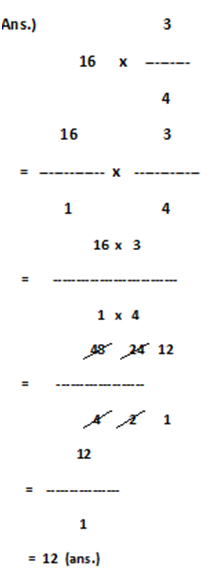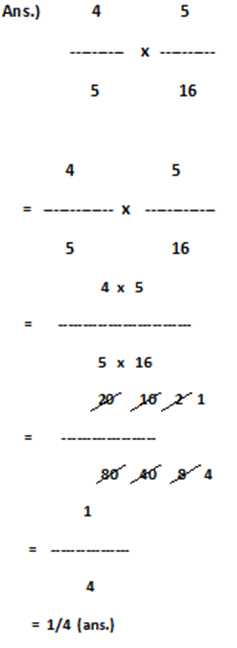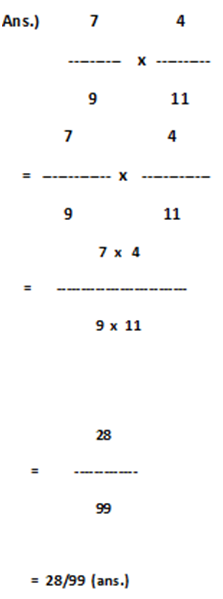CLASS-5
MULTIPLICATION OF FRACTIONAL NUMBER
MULTIPLICATION OF FRACTIONAL NUMBER
1) Multiply 16 by 3/4

Step 1.
In the above problem/Multiplication, we can observe that in the first number there
is no ‘Denominator’, only ‘Numerator’ 16 is there. so, let us assume 1 is
‘Denominator’ of ‘Numerator’ 16, so the fraction is 16/1.
Step 2. Now, multiply all the ‘Numerator’ obtained from both fraction and like the same multiply all the ‘Denominator’ obtained from both fraction and you will find a new fraction. 16 x 3 = 48 & 1 x 4 = 4 So, new fraction is 48/4.
Step.3 Now simplify the new fraction 48/4 obtained from said the multiplication via division method by the same prime number to ‘Numerator’ and ‘Denominator’ at a time again and again until it reaches to the prime number itself (both Numerator & Denominator).
So, the desired answer is 12. (Ans.)
2) Multiply 4/5 by 5/16.

Step 1. In the above problem/Multiplication, we can observe that, in first number 4 is ‘Numerator’ and 5 is ‘Denominator’. In second fractional number 5 is ‘Numerator’ and 16 is ‘Denominator’
Step 2. Now, multiply all the ‘Numerator’ obtained from both fraction and like same multiply all the ‘Denominator’ obtained from both fraction And you will find new fraction. 4 x 5 = 20 & 5 x 16 = 80. So, new fraction is 20/80.
Step.3 Now simplify the new fraction 20/80 obtained from said the multiplication via division method by the same prime number to ‘Numerator’ and ‘Denominator’ at a time again and again until it reaches to the prime number itself (both Numerator & Denominator).
So, the answer is 1/4 . (Ans.)
3) Multiply 7/9 by 4/11.

Step 1. In the above problem/Multiplication, we can observe that, in first number 7 is ‘Numerator’ and 9 is ‘Denominator’. In the second fractional number 4 is ‘Numerator’ and 11 is ‘Denominator’.
Step 2. Now, multiply all the ‘Numerator’ obtained from both fraction and like the same multiply all the ‘Denominator’ obtained from both fraction and you will find a new fraction.
7 x 4 = 28 & 9 x 11 = 99.
So, new fraction is 28/99.
Step.3 Now simplify the new fraction 28/99 obtained from said the multiplication via division method by the same prime number to ‘Numerator’ and ‘Denominator’ at a time again and again until it reaches to the prime number itself (both Numerator & Denominator). But we can observe that, no number can divide at a time both ‘Denominator’ & ‘Numerator’, so 28/99 is the simplest form and this is the desired answer. (Ans.)